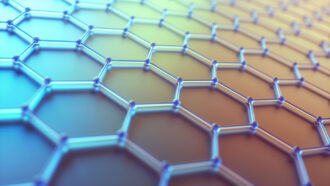Physics

Educators and Parents, Sign Up for The Cheat Sheet
Weekly updates to help you use Science News Explores in the learning environment
Thank you for signing up!
There was a problem signing you up.
-
 Materials Science
Materials ScienceScientists Say: 2-D Material
Two-dimensional materials such as graphene could improve electronics, carbon capture and more.
-
 Physics
PhysicsHow much fruit can you pull from a display before it topples?
About 10 percent of the fruit in a tilted market display can be removed before it will crash down, computer models show.
-
 Materials Science
Materials ScienceLet’s learn about graphene
Scientists have been trying to understand and harness this material’s superpowers since its discovery in 2004.
-
 Physics
PhysicsScientists Say: Polarized light
Sunlight, lamplight and other lights are usually unpolarized. But passing light waves through filters can ‘polarize’ them.
-
 Physics
PhysicsNeutrons are unveiling hidden secrets of fossils and artifacts
Images made with these particles have revealed details of dinosaur bones, mummies and more.
-
 Physics
PhysicsScientists Say: Coriolis Effect
Because Earth spins, airborne objects traveling far and fast — such as airplanes — experience deflections in their motion.
-
 Physics
PhysicsBefore the ancient Egyptians, nature may have carved sphinxes
Steady ‘winds’ can carve clay blobs into lion-shaped landforms called yardangs, a new study suggests. One such yardang may have inspired the Great Sphinx of Giza.
By Elise Cutts -
 Tech
TechBalsa wood transistors could usher in ‘greener’ electronics
Researchers in Sweden coaxed wood to conduct electricity, then used it to make a climate-friendlier building block of electronics.
-
 Health & Medicine
Health & MedicineScientists Say: Calorie
These little units help us measure energy transfer in chemistry, nutrition and beyond.
-
 Physics
PhysicsExperiment: Where does a bouncing basketball’s energy go?
Let’s explore whether energy loss to heat could explain why a basketball doesn’t bounce back to its original height.
-
 Chemistry
ChemistryPollution power? A new device turns carbon dioxide into fuel
Scientists made a device that converts the greenhouse gas into formate. This salt can then run a fuel cell to make electricity.
By Laura Allen -
 Physics
PhysicsScientists Say: Muon
Tracking muons raining down on Earth can reveal new details of pyramids, volcanoes and thunderstorms.